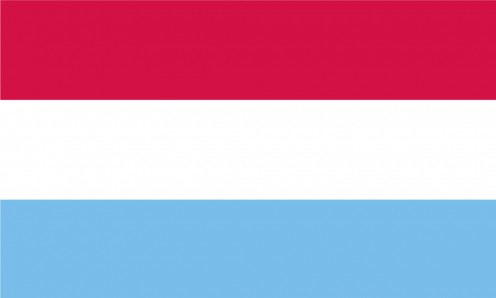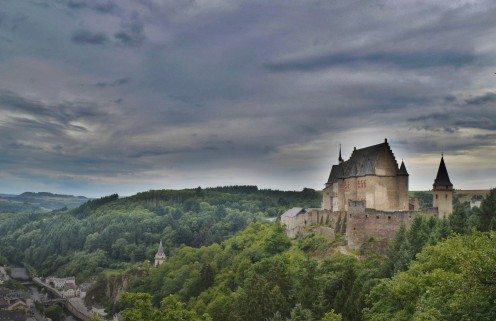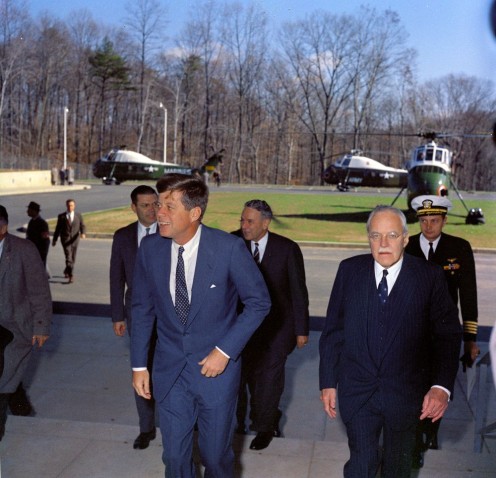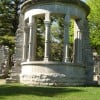Visiting Vianden Castle, Luxembourg: Remembering a 1944 Battle, and Hidden Clues to Post-War Developments


In the fog of war, nebulous relations between Luxembourg socialists and trade unionists and the OSS?
This fine, Medieval castle in the Grand Duchy of Luxembourg — formerly the family property of the Grand Dukes — was the scene of a battle in 1944 before the Battle of the Bulge, in which American forces distinguished themselves at great cost. (A craggy, Medieval castle built upon an outcrop of rock, overlooking a town near the meandering Our River which for much of its course forms the border with Germany: it almost seems the stuff of legend.)
While the Battle of Vianden was not hugely significant in strategic terms, it did prove to be important in terms of subsequent internal Luxembourg affairs; its broader context also provides some clues to post-War developments.
In November 1944 the forces of the Wehrmacht were in retreat and, while later during the Battle of the Bulge the Oesling (Létzebuergesh: Éislek) was reoccupied briefly by the German army, it was the Luxembourg Resistance — rather than the regular Allied armies — that took possession of Vianden Castle, near the German border.
On November 19, 1944, during the Battle of Vianden, the Luxembourg Resistance forces successfully resisted attempts by Waffen SS units to retake Vianden Castle. Afterwards, Victor Abens (1912-1993), one of the local Resistance leaders, who fought in the Battle of Vianden, stood for election as Mayor of Vianden, in which capacity he served for decades, as well as later being elected to both the Luxembourg and European Parliaments. Thus there is a sense in which at the Battle of Vianden there was being forged in part what turned out to be many years of a post-War political career, based in some measure on Victor Abens's war record in the Resistance.
Historian Julian Jackson has written regarding the Resistance in neighbouring France: "In the history of France, Resistance is more important as a social and political phenomenon than a military one" (1) and this, it would seem, proved in a measure to be true in the Grand Duchy of Luxembourg also.
However, there are also some other interesting considerations regarding the activities of Victor Abens's Luxembourg socialist colleagues during World War Two, which, though less apparent, may have had a considerable post-War impact.
It is known, for example, that the US Office of Strategic Services (OSS) was actively engaged with representatives from the Benelux countries in supplying funding to Resistance groups in these countries during World War Two. Luxembourg trade union leaders Pierre Clement and Antoine Krier acted as trustees of funds, ostensibly from AFL and CIO funds in the US for the support of underground labour movement in Luxembourg and the other Benelux countries. Geert van Goethem has written: 'It was clear from the outset that the money was going to be used for military purposes ... and that the humanitarian aspect was only a cover' (2).
Tellingly, these funds were channelled through the OSS office in Berne, Switzerland, headed by Allen W. Dulles (1893-1969; see photo, below, with Mr. Dulles, later Director of US Central Intelligence, depicted with President John F. Kennedy in 1961).
Indeed, although the sums of money involved were not huge, there is evidence that these funds were actually solicited by Luxembourg socialist leader and trade unionist Pierre Krier (1885-1947; see photo, below).
Geert van Goethem has written that, while admittedly war conditions made for understandable cooperation between trade unions and exile governments and secret services, this does beg the question of 'who was really leading who(m)?' (3)
Great Britain's Special Operations Executive (SOE), promoted by Prime Minister Winston Churchill, whose goal thereby was to 'set Europe ablaze', with fairly little focus on a post-War political strategy for the Nazi-occupied countries of Europe.
But the OSS, for which Allen Dulles proved to be a most formidable operator in Europe from his base in Berne, is recognized as having pursued a political agenda for a post-World War Two European continent, even as World War Two still raged, even as OSS-supported socialists and trade unionists ostensibly built themselves reputations in the struggle against Nazism.
'Who was really leading whom', indeed!
August 31, 2017
Notes
(1) Julian Jackson, qu. in: Max Hastings, Finest Years: Churchill as Warlord 1940-45, London: HarperPress, 2010, p. 461
(2) Geert van Goethem, The Amsterdam International: The Work of the International Federation of Trade Unions (IFTU), 1913-1945, Aldershot, England / Burlington, VT, USA: Ashgate Publishing, 2006, p. 273.
(3), Geert van Goethem, op. cit., p. 276.
Some sourcing: Wikipedia.
Also worth seeing
The town of Vianden (Létzebuergesch: Veianen) itself has a museum dedicated to Victor Hugo and some interesting ecclesiastical architecture.
Roth-an-der-Our, Germany (distance: 2.6 kilometres); the main part of this village on the Our River is three-quarters surrounded by the territory of Luxembourg; its noted buildings include a 17th century castle and a towered gate.
...
How to get there: The nearest large international airport to Vianden is Luxembourg (Aéroport de Luxembourg ), at Findel, from where car rental is available. Some facilities may be withdrawn, without notice. Please check with the airline or your travel agent for up to date information. You are advised to refer to appropriate consular sources for any special border crossing arrangements which may apply to citizens of certain nationalities.
MJFenn is an independent travel writer based in Ontario, Canada.



Other of my hubpages may also be of interest
- Visiting Bivels, Luxembourg: a bridge to Germany; recalling post-WW2 annexation, and the road to a p
Mlitary issues relevant beyond a border village's past may have had Alice in Wonderland features, but a thoroughly modern state with an internationally integrated miltary has more recently emerged - Visiting an amazing piece of Roman real estate in Trier, Germany: the Porta Nigra
This building is just amazing. A cliché, perhaps? Not when one is speaking of the Roman structure, the Porta Nigra, in the city of Trier, in Germany's Rhineland-Palatinate (Rheinland-Pfalz ). This is the question which the observer is...







